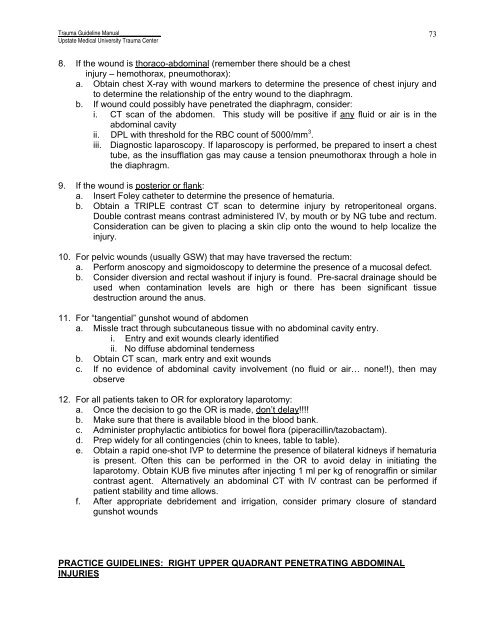Trauma Guideline Manual - SUNY Upstate Medical University
Trauma Guideline Manual - SUNY Upstate Medical University
Trauma Guideline Manual - SUNY Upstate Medical University
Create successful ePaper yourself
Turn your PDF publications into a flip-book with our unique Google optimized e-Paper software.
<strong>Trauma</strong> <strong>Guideline</strong> <strong>Manual</strong>______________<strong>Upstate</strong> <strong>Medical</strong> <strong>University</strong> <strong>Trauma</strong> Center738. If the wound is thoraco-abdominal (remember there should be a chestinjury – hemothorax, pneumothorax):a. Obtain chest X-ray with wound markers to determine the presence of chest injury andto determine the relationship of the entry wound to the diaphragm.b. If wound could possibly have penetrated the diaphragm, consider:i. CT scan of the abdomen. This study will be positive if any fluid or air is in theabdominal cavityii. DPL with threshold for the RBC count of 5000/mm 3 .iii. Diagnostic laparoscopy. If laparoscopy is performed, be prepared to insert a chesttube, as the insufflation gas may cause a tension pneumothorax through a hole inthe diaphragm.9. If the wound is posterior or flank:a. Insert Foley catheter to determine the presence of hematuria.b. Obtain a TRIPLE contrast CT scan to determine injury by retroperitoneal organs.Double contrast means contrast administered IV, by mouth or by NG tube and rectum.Consideration can be given to placing a skin clip onto the wound to help localize theinjury.10. For pelvic wounds (usually GSW) that may have traversed the rectum:a. Perform anoscopy and sigmoidoscopy to determine the presence of a mucosal defect.b. Consider diversion and rectal washout if injury is found. Pre-sacral drainage should beused when contamination levels are high or there has been significant tissuedestruction around the anus.11. For “tangential” gunshot wound of abdomena. Missle tract through subcutaneous tissue with no abdominal cavity entry.i. Entry and exit wounds clearly identifiedii. No diffuse abdominal tendernessb. Obtain CT scan, mark entry and exit woundsc. If no evidence of abdominal cavity involvement (no fluid or air… none!!), then mayobserve12. For all patients taken to OR for exploratory laparotomy:a. Once the decision to go the OR is made, don’t delay!!!!b. Make sure that there is available blood in the blood bank.c. Administer prophylactic antibiotics for bowel flora (piperacillin/tazobactam).d. Prep widely for all contingencies (chin to knees, table to table).e. Obtain a rapid one-shot IVP to determine the presence of bilateral kidneys if hematuriais present. Often this can be performed in the OR to avoid delay in initiating thelaparotomy. Obtain KUB five minutes after injecting 1 ml per kg of renograffin or similarcontrast agent. Alternatively an abdominal CT with IV contrast can be performed ifpatient stability and time allows.f. After appropriate debridement and irrigation, consider primary closure of standardgunshot woundsPRACTICE GUIDELINES: RIGHT UPPER QUADRANT PENETRATING ABDOMINALINJURIES
















